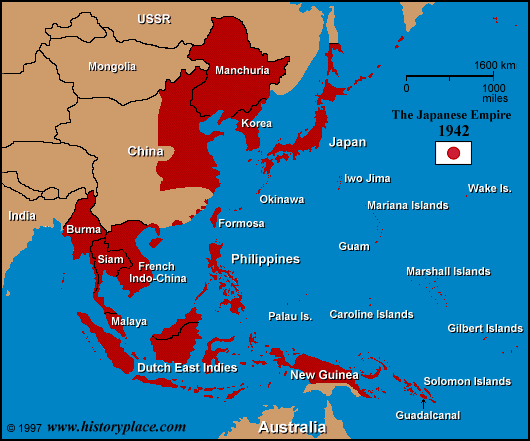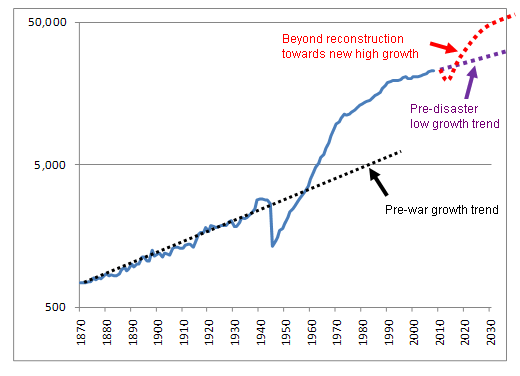Map of the Japanese Empire at its peak in 1942
 |
| Source: The History Place: World War II in the Pacific |
In the next three years as the Allies defeated Germany and Italy, they brought more force to the war in the Pacific. Japan lost its navy and shipping, its air force and most of the force of its army. In August of 1945 the Soviet Union joined the forces against it. Bombings were destroying Japan's cities, with an estimated 100,000 killed in a single incendiary bombing of Tokyo and two cities destroyed by atom bombs. Shocking the population that had been undergoing propaganda for years to prepare them to fight to the last man, Japan surrendered unconditionally.
Embracing Defeat
I just finished reading Embracing Defeat: Japan in the Wake of World War II by John W. Dower. The book deals with the way in which the Japanese responded to the defeat during the occupation by American troops which continued through 1952.
Japan had millions killed during the war. At the end of the war it was stripped of its colonies; the scattered remnants of its military had to return to Japan as did the civilians occupying its former colonies. Millions had deserted the bombed out cities. Factories had been hard hit. There was a disastrously poor harvest. The economy was in ruins.
The facts of the Holocaust were becoming known to a shocked world. Japan had its own atrocities to deal with, including the rapes of Nanking and Manila, the deaths of a million forced laborers in Indonesia, the deaths of 27 percent of White prisoners of war, and systematic medical experimentation on unwilling human subjects were only the most sensational of these.
The immediate response of the Japanese people was depression. They discovered that they had been subject to propaganda for years. That the government in the hands of the military had embarked on a stupid war, one that Japan had little hope of winning.
The day-to-day existence of the people was occupied by the search for enough food to sustain life. Many were without shelter, many without work. The black market which developed very rapidly was the necessary source for many of the necessities of life, but those necessities were increasingly hard to buy due to the raging inflation. Corruption was widespread, and huge amounts of government property were stolen.
According to Dower, Japanese focused heavily on the responsibility for defeat rather than on the responsibility for starting an aggressive and ultimately unwinnable war or that for the atrocities committed by Japanese.
The Occupation
A quarter of a million American service men manned the occupation, including several thousand in the General Headquarters. General Douglas MacArthur, an exceptional officer and man, had command; he came to be seen as exercising imperial power over that of the Japanese Emperor (yet he could bargain for speed from the Japanese by insisting that if they did not follow his directives quickly enough, his superiors in Washington and the Allied Command would impose more draconian policies). Supported by up to one-quarter of the Japanese government's budget, the occupying force lived much better than their Japanese hosts. They were very visible in everyday life in the cities, but invisible in the highly censored media.
The GHQ began with initial orders to democratize and demilitarize Japan in order to prevent any future Japanese aggressive war, but with the onset of the Cold War and especially the Korean War moved to promote anti-Communism and to develop Japan as a source of military supplies for the Korean War. Dower describes the Occupation as being marred by poor understanding of the Japanese culture and people and by racism.
Yet, Dower shows that the Occupation had major impacts on Japan. Notably, billions of dollars of aid were provided by the United States in the early years to prevent wide spread starvation, and even more billions were introduced into the Japanese economy to buy materials for the Korean War. Allowing rapid inflation in the early part of the Occupation reduced the debt and reduced the economic power of elites; harsh readjustment followed by heavy stimulus led to a strong economy.
Japanese Thought
Drawing heavily on published sources from the time, Dower shows the diversity of thought within Japan. He distinguishes between popular culture and that of the intellectual elite. Thus he shows a diversity of political opinion ranging from establishment conservatives, to socialists and Marxists, to pro Americans and to those most interested in just getting on with their lives.
While condemnation of the military and governmental leaders that led the war effort was widely shared, there was considerable discussion as to the form that government and the economy should take in the future. Among conservatives there was great support for the Emperor, while there was less concern than had been expected when his status was reduced.
Japan was highly literate and there were thousands of newspapers and magazines in publication, including a large number of poetry magazines. Radio was well established and was on for 5 or more hours a day in many households. More than 1000 Japanese movies were produced under the Occupation and foreign films were also available. While censored by the Occupation the media were less censored after the war than by the Japanese military government during the war. The flood of information available to the Japanese clearly influenced them in accepting the wartime defeat, adapting to its lessons, and getting on with the business of the nation.
Revisions in Japanese Institutions
There was complete demilitarization in the early days of the Occupation. With the Korean War, a 75,000 man defense force was established, but the Japanese were wary of any idea to introduce Japanese forces into Korea. The military was barred from participation in civilian government.
Since the Meiji Restoration Japanese government had been based on the sovereign power of the emperor who was considered to be both the descendant of a goddess and divine in his own person; he was regarded as the leader of a people descended from the gods. After the defeat, the Emperor was declared human and reduced to something more like the English monarch; sovereignty was assigned to the people.
Human rights were greatly reinforced as part of the democratization effort. Notably, the rights of women were enhanced. Universal suffrage was introduced. Unionization was promoted (remember that the New Deal Democrats remained in charge in Washington), and worker safety codes were introduced.
A new Constitution was introduced, one which remained unamended for half a century after it was ratified. Dower shows that it was in fact based on a draft written in the GHQ, albeit one informed by other constitutions than that of the United States; it was discussed and modified both with the cabinet and in the legislature. The new constitution outlawed the peerage and established a bicameral elected legislature with a Prime Minister and Cabinet.
The economy was significantly altered. Land reform undermined the power of the large landholders. The vertical integration of the industrial zaibatsu was replaced by the horizontal coordination of the keiretsu, and family control was replaced by bureaucratic control responsible to broad communities of stockholders. MITI was created giving the government a major role in industrial guidance. Small and medium size enterprises showed considerable technological innovation in meeting the challenges of demilitarization and consumer needs. Government policies were created to promote scientifically based innovations in industrial technology.
The results were a much more peaceful nation and a people with considerably more freedom and political influence. Remnants of feudalism were extirpated. The rate of economic growth, after the immediate downturn, was increased significantly for two decades as compared with that in the pre-war period as is shown in the following figure.
Japan's real per-capita GDP (in U.S. dollars)
 |
| Source: Beyond Reconstruction and Moving Towards New High Growth |
Dower mentions some aspects of Japanese culture, such as the respect for the long continuity of the monarchy and its mythological basis. He suggests that there is an emphasis on responsibility to the family and immediate community and relative unconcern with the welfare of strangers. (He mentions the surprise of Japanese about the relative willingness of GIs to help out and give gifts to strangers.)
I think that Japanese culture is unusual in the ability of Japanese to experiment with foreign innovations -- accepting or rejecting them according to their perceived utility -- while at the same time consciously preserving cultural features from the past that are perceived as critical to their being Japanese. Dower does not mention Japanese efforts to preserve Sumo wrestling, No theater, Kabuki, and other elements of intangible Japanese culture while simultaneously developing strong new industries in areas such as automobile manufacturing and consumer electronics. The Japanese accepted demilitarization (far more readily that would other powers such as the Unites States) when they became convinced that it had been destructive to the nation, while the Japanese continue to gather to view the cherry blossoms in season.
Plus ça change, plus c'est la même chose.
The Japanese have changed, but they remain Japanese, different than other nations. "The water flows, but the river remains."
How Good is the Book?
Embracing Defeat was a winner of the Pulitzer Prize. It won the 1999 National Book Award for Nonfiction, was a finalist for the Lionel Gelber Prize and the Kiriyama Pacific Rim Book Prize. This is a wonderful book, providing a multifaceted view of an exceptional time and place.
It is based primarily on documentary sources, as is necessary for a historian writing about events a half century in the past. Still that approach can never really convey the range of experiences of individuals. Nor can it give a statistically valid view of the diversity of opinion and experience.
It is based primarily on documentary sources, as is necessary for a historian writing about events a half century in the past. Still that approach can never really convey the range of experiences of individuals. Nor can it give a statistically valid view of the diversity of opinion and experience.
I am not sure that the experience of post war Japan's shift from militarism to pacifism is transferable to other situations. What may be transferable are lessons from the book.
- That undertaking radical cultural change is better done with extensive and detailed knowledge of the culture.
- That it is important to bring expertise in economics, law, and other fields to the table.
- In Japan, as in many other nations, there existed considerable knowledge and expertise in the society but that much of it had not been utilized. Allowing the sources of expert knowledge to freely circulate their ideas was important.
- Cooping key players in policy making and implementation is important.
- That it is easy to underestimate the people, and wrong to do so.
- That outside influence on the side of democracy and improved economic institutions helped.
- That the rebuilding of a nation is a hugely complex process, perhaps impossible to fully understand, and perhaps best guided by the people of the nation themselves.

No comments:
Post a Comment